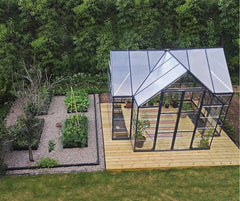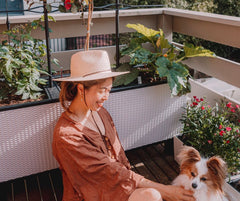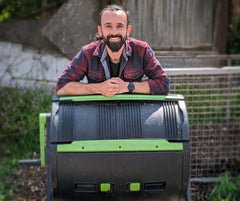
Caring for Worms as We Head into Summer
When summer’s heat arrives, it’s time to turn our attention to the wellbeing of our worms.
At Maze, we’re passionate about sustainable gardening and believe that caring for our worm farms in hot weather is essential for both worm health and the quality of your compost.
We'll explore our best strategies for heat protection, moisture control, and troubleshooting, all grounded in the expertise behind our worm farm solutions.
Why Is Summer So Critical for Worm Farm Health?
Worms thrive in consistent, moderate temperatures. When exposed to excessive heat, they become stressed, which can cause them to stop processing organic waste, or worse, perish.
As we approach the warmer months, monitoring your worm farm is vital to prevent overheating, dehydration, and other common summer issues.
Whether you’re using the Maze Worm Farm (with or without Legs), our compact 3-tier, or a Hungry Bin Worm Farm, these care tips apply across all products.
Let’s dive deeper into keeping your worm bins cool, moist, and productive.

1. Preventing Your Worm Farm from Overheating
When the forecast shows hot days ahead, proactive planning can make all the difference. Here’s what we do at Maze to protect worms from excess heat:
- Find a Cool Spot: Move your worm farm to a shaded location away from direct sunlight, under a tree, in a shed, or along the shaded side of your home.
- Insulate Above and Below: Place a thick layer of damp newspaper, cardboard, or a Maze hessian sack on top of the bedding. You can also elevate the worm farm on bricks to promote airflow.
- Add Extra Moisture: Spraying the surface bedding lightly in the morning or evening ensures it stays damp without becoming waterlogged.
- Use Ice Blocks Carefully: On extreme days, pop a frozen water bottle (with the lid on) atop the bedding, it will gradually release coolness as it melts, helping maintain a safe temperature.
- Minimise Disturbance: Try not to overfeed or open the farm excessively in heatwaves.
** Accessories like our 3pk Pop up SHADE Cover can offer additional portable protection.
2. Watering Routines and Moisture Management
Moisture is the key to a resilient worm farm. Too little water and your worms risk dehydration; too much and you can create an acidic, anaerobic environment.
- Frequency: In peak summer, check moisture levels daily, ideally morning and afternoon. Bedding should feel like a wrung-out sponge: moist but not dripping.
- How to Water: Use a fine spray or add water gradually. With our multi-tray systems, you can gently water the top tray so moisture filters through, and using a Liquid Collection Jug is perfect to catch all the excess.
- Look for Signs: Bedding that sticks together too easily means you’ve overwatered. Dry, crumbly bedding (or obvious surface worms) signals it’s time for a drink.
Remember, climate and worm farm location influence how often you need to water, so always adjust your routine based on sight and touch.

3. Signs of Stress in Your Worms (and How to Respond)
Vigilant observation will clue you in to heat stress and dehydration:
- Surface Crawling or Mass Escape: If worms are clustering on the lid or trying to leave, conditions are uncomfortable, most often due to heat or excess moisture.
- Sluggish Movement: Stressed worms move less, and their bodies may become lighter in colour or shrivelled.
- Unpleasant Odour: A healthy worm farm smells earthy, not sour, strong smells may indicate food has become anaerobic or conditions are too wet.
- Visible Dehydration: Dry, thin worms need immediate water. Mist bedding evenly or add moist scraps and cover with damp newspaper.
Should you notice any of these, review your location, insulation, and watering practices straight away.
4. Maintenance Checklist for a Healthy Summer Worm Farm
🪱 Move farm before a heatwave to a shaded, ventilated position
🪱 Top up bedding with moist, cool material each week
🪱 Use a thermometer or simply touch-test bedding regularly
🪱 Remove uneaten scraps if they show signs of rot or attract pests
🪱 Keep feeding amounts small during the hottest periods
5. Troubleshooting: FAQs
How do we stop our worm farm from overheating?
Relocate it to shade, insulate with damp newspaper or hessian, and try a frozen bottle trick on severe days. If you have a Maze Worm Farm on legs, this assists with airflow, but moving and monitoring is still essential.
How often should we water our worm farm during summer?
Inspect moisture every day. In very hot or dry climates, twice-daily misting is sometimes needed. Each worm farm, from our smaller compact worm farm to large multi-tray systems, can be adjusted to find the right balance.
What are the tell-tale signs of heat stress in worms?
Surface escapes, worms losing body mass, pale colour, and unpleasant odour all indicate stress. Address these issues quickly with improved shade, adjusted watering, or reduced feeding.

6. Must-Have Maze Products for the Summer Worm Farmer
- Maze Worm Farm (Wood Legs and Worms)
- Maze Multi-Tray Worm Farm
- Kitchen Compost Caddies
- Maze Shade Cloth
- Coconut Coir Bedding
Caring for worms in the heat is a seasonal task that rewards us, and our soil all year round.
For more tips visit our blog and let’s keep our gardens thriving, together.




